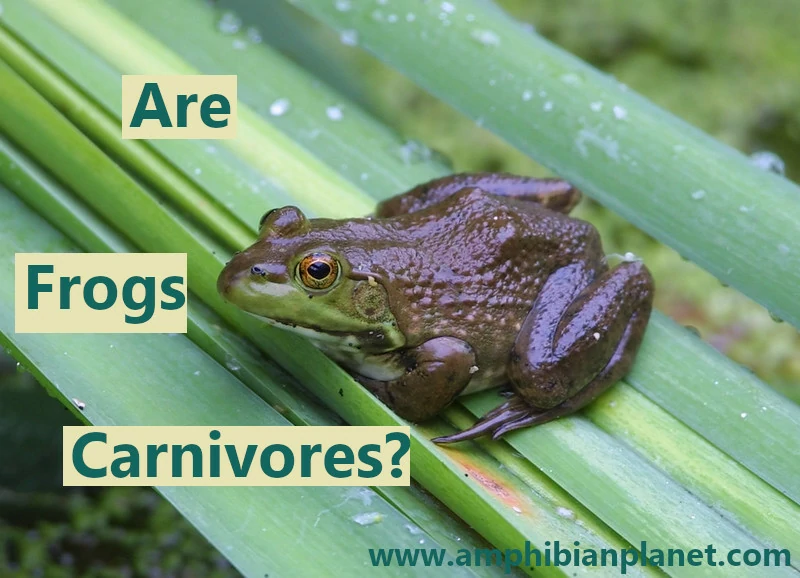Frogs are amphibians, which means they live part of their lives in the water and part on land. They typically start their lives as fully aquatic tadpoles, which develop and metamorph into mature frogs over time. In each of these life stages, frogs will have different diets.
Frog tadpoles are mostly herbivorous. As they grow, the tadpoles become omnivores and will eat animal protein, in addition to plants. Once the tadpoles go through the process of metamorphosis and transform into frogs – they become obligate carnivores, and will only eat animal-based foods.
Adult frogs opportunistic predators that will eat almost any prey they can catch, overpower, and fit into their mouths.
They also have short digestive tracts, suited for their strictly carnivorous diets.
Frog Tadpoles Are Mostly Herbivorous
Frogs start their lives as tiny embryos inside egg sacs. Their first food source for the developing embryos is the yolk of their eggs.
The yolk provides enough nutrition to sustain the developing tadpoles until they are ready to hatch into the water. This can take anywhere from a few days to as long as 6 weeks, depending on the species.
After hatching, the tadpoles will have poorly developed gills, mouths, and tails – so they can not properly swim or eat yet.
For this reason, they will spend the first few days feeding on the remaining yolk of the eggs. This will provide them with enough energy to grow and develop further.
After about a few days, the tadpoles would have developed enough to start free swimming and feeding on food sources available in the water.
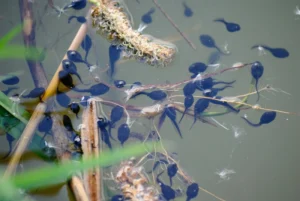
At this early stage, tadpoles are almost completely herbivorous, and will eat:
- Algae
- Soft roots and leaves of aquatic plants (eg. duckweed mosses)
- Phytoplankton
- Detritus (mostly composed of degraded plant materials)
Tadpoles have little or no tongue-like tissue and will eat by sucking the food into their throat and the food enters the long intestine where it is digested.
Due to a mostly herbivorous diet, tadpoles have very long tightly coiled intestines, that make up more than half of their body mass.
Plants contain cellulose, a compound that is very hard to digest. Because of this, plant matter needs to spend more time in the digestive system. This long intestinal tract gives tadpoles more time to break down the plant matter and absorb as many nutrients as possible.
The intestine takes up about half the space within the tadpole’s body and can be more than ten times longer than the tadpole itself.
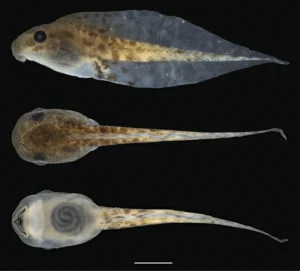
It is also its largest organ and is visible through the translucent belly skin.
Tadpoles Become Omnivores
A few weeks into development (can vary depending on the species), the tadpoles start to grow legs, starting with the back legs. Their digestive tract will also gradually shorten.
Tadpoles at this stage become omnivores and will eat animal matter in addition to plants.
They will also eat:
- Aquatic insect larvae (glass worms, mosquito larvae, etc)
- Water striders
- Zooplankton
- Small insects that fall into the water
- Worms
- Carcasses in the water
Large tadpoles may also eat small and immature fish, small snails, slugs, fairy shrimp, and other small aquatic invertebrates.
Food Item |
Early Tadpole |
Late Tadpole |
| Algae | Yes | Yes |
| Plankton | Yes | Yes |
| Aquatic plants | Yes | Yes |
| Detritus | Yes | Yes |
| Ants | No | Yes |
| Small insects | No | Yes |
| Worms | No | Yes |
| Carcasses | No | Yes |
| Fish eggs | No | Yes |
| Fairy shrimp | No | Yes |
Tadpoles Turn Into Froglets
After a few months, to a few years (depending on the species) the tadpoles will go through a process known as metamorphosis, in which they will transform into juvenile frogs.

During metamorphosis, the thyroid gland secretes a growth hormone called thyroxine.
This hormone triggers the tadpoles to:
- Lose the gills, and develop lungs for breathing air
- Absorb the tail into the body
- Grow strong legs for moving on land
- Remodel other organs to form an adult frog
The tadpole’s beak is also shed, the denticles are reabsorbed, the mouth as a whole widens, and many frogs’ true teeth form.
The head structure also begins to change, leading to the development of a more defined jaw and the formation of a tongue.
In addition, the digestive tract shortens dramatically, and the inner lining of the remaining intestine thickens, creating many folds in the process. These folds create a very large surface for the absorption of nutrients during digestion.
As the gut shrinks, a stomach is formed that secretes pepsin – an enzyme that is important for digesting proteins found in animal-based food.
Once metamorphosis fully is complete, the tadpoles are now young frogs and will leave the water for a mostly terrestrial, or semi-aquatic life (depending on the species).
These juvenile frogs will grow into adult frogs, and once they reach sexual maturity, they will typically go back to the water to mate and lay their eggs.
Froglets and Adult Frogs Are Obligate Canivores
Once the metamorphosis from tadpole to frog is complete – frogs become obligate carnivores, meaning they only eat animal-based foods and will not eat any plants.
They will eat:
- Worms
- Snails, slugs
- Insects (grasshoppers, locusts, cockroaches, beetles, moths, flies, bees, etc)
- Ants, termites, mites, springtails
- Spiders, centipedes, Millipedes
- Maggots, grubs
Larger frog species also eat small fish, small birds, bats mice, small snakes, small lizards, and even smaller frogs, sometimes of their own species (yes, they can be cannibals).
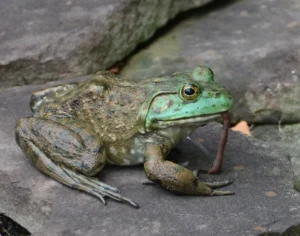
Frogs have sticky tongues that allow them to catch any moving insect that comes into range quickly.
A frog can shoot out its tongue, capture an insect and pull it back into its mouth within 07 seconds; which is five times faster than the human eye can blink. This speed makes it effective at catching even fast-flying insects such as flies.
Most frogs are instinctively attracted to movement while hunting for food, and will not eat dead bugs or any other dead prey items.
Food Item |
Small Frogs |
Large Frogs |
| Ants | Yes | Yes |
| Insects | Yes | Yes |
| Worms | Yes | Yes |
| Snakes | No | Yes |
| Snails & Slugs | Yes | Yes |
| Spiders | Yes | Yes |
| Centipedes & Millipedes | Yes | Yes |
| Lizards | No | Yes |
| Mice | No | Yes |
| Birds | No | Yes |
| Bats | No | Yes |
| Vegetables | No | No |
| Fruits | No | No |
| Flowers | No | No |
| Leaves | No | No |
| Grass | No | No |
| Algae | No | No |
Froglets and Adult Frogs Have a Digestive System Suited for a Carnivorous Diet
Adult frogs have short alimentary canals, suited for their strictly carnivorous diets.
Carnivorous animals like frogs generally have shorter digestive tracts than herbivores – because meat is dense in nutrients and they can extract these nutrients easier.
Their stomachs also make up a larger part of their digestive system than herbivores.
In addition, frogs have very powerful digestive enzymes, that help them to easily digest animal protein.
However, adult frogs may occasionally ingest plant matter when they eat hunt and eat prey – but they will never deliberately eat plants.
Here is a table that summarizes everything easier:
Life Stage |
Diet |
| Early Tadpole | Herbivore |
| Late Tadpole | Omnivore |
| Froglet | Obligate Carnivore |
| Adult frog | Obligate Carnivore |
Some Adult Frog/Toad Species Are Omnivores
Cane toads (Rhinella marina) mostly eat insects, worms, snails, smaller frogs, small mammals, and other prey items.
However, they have also been observed eating carrion, processed cat and dog food, household garbage scraps, and even animal excreta.
This means they are omnivores, rather than obligate carnivores, like most frogs are in the adult life stage.
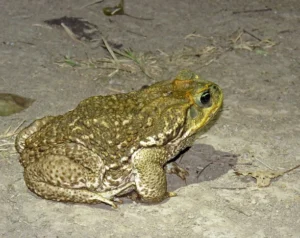
Unlike most frogs that find their prey by movement, cane toads primarily use vision to find prey, and can also use their sense of smell to find food, such as dog food left outdoors.
Izecksohn’s Brazilian tree frogs are Unique
There is one frog that is known to eat plants as part of its regular diet: the Izecksohn’s Brazilian tree frog (Xenohyla truncata).
These frogs unique in that they are the only known frugivorous frog, out of more than 7,000 frog species in the world. They intentionally and often eats fruits, leaves, and flowers.
The amount of plant matter eaten by Izecksohn’s Brazilian tree frogs will depend on the blooming and fruiting seasons of the plants. When plants are unavailable, these frogs will eat various arthropods instead.
Since these frogs eat plants, in addition to animal matter, they are omnivores – rather than obligate carnivores.
The Tadpoles of Some Frog Species Can Morph, and Change Deits
The tadpoles of some frog/toad species display phenotypic plasticity, which means they can change how they look and act, and how their tissues function, in response to their environment.
Examples of this, are the North American spadefoot toads (Scaphiopodidae).
The tadpoles of these toads are polymorphic: meaning they can develop in more than one form.
When algae and tiny prey are abundant, the tadpoles have jaw muscles and mouthparts that are proportioned when compared to the rest of the body. These are “normal” spadefoot tadpoles known as ‘omnivore morphs.’
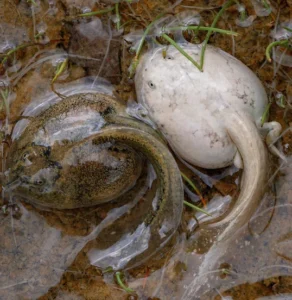
However, if the pond also contains fairy shrimp, some spadefoot tadpoles turn into aggressive ‘carnivore-morph’ tadpoles.
They do this to take advantage of the extra food source and grow faster. Growing faster enables them to go through metamorphosis sooner, and leave the pond before the water dries up.
Despite being the same age as ‘normal’ spadefoot toad tadpoles, carnivore-morph tadpoles are larger, and have bigger, broader heads, a slimmer body, and smaller digestive tracts.
They also have keratinized mouthparts that are bigger and have serrated edges, with a dorsal hook.
These two morphs behave differently: omnivore-morph tadpoles gather in schools, while carnivore-morph tadpoles are solitary.
Carnivore-morph spadefoot tadpoles, don’t just eat fairy shrimp, they also eat other prey, and often become cannibalistic and eat other tadpoles.
Common Questions
Do frogs eat meat? The vast majority of frog species, are obligate carnivores as adults and will only eat animal-based foods. However, frogs are generally attracted to movement when hunting for food, so they only eat live prey. They will not not “human food” like beef or chicken – and will also ignore dead bugs.
How do frogs hunt? When on land, most frogs are ambush hunters and sit in shady areas to pounce on any prey that passes by. However, they can also actively chase slow-moving prey such as worms, or snails. When in the water, most frogs are active hunters and often chase after prey, as they are excellent swimmers.
Sources:
Bragg, Arthur N. “Further Study of Predation and Cannibalism in Spadefoot Tadpoles.” Herpetologica, vol. 20, no. 1, 1964, pp. 17–24. JSTOR, http://www.jstor.org/stable/3890877.
Pfennig DW. Cannibalistic tadpoles that pose the greatest threat to kin are most likely to discriminate kin. Proc Biol Sci. 1999 Jan 7;266(1414):57. doi: 10.1098/rspb.1999.0604. PMCID: PMC1689646.
Altig, Ronald & Whiles, Matt & TAYLOR, CINDY. (2007). What tadpoles really eat? Assessing the trophic status of an understudied and imperilled group of consumers in freshwater habitats. Freshwater Biology. 52. 386 – 395. 10.1111/j.1365-2427.2006.01694.x.
Wassersug R. How does a tadpole know when to metamorphose? A theory linking environmental and hormonal cues. J Theor Biol. 1986 Jan 21;118(2):171-81. doi: 10.1016/s0022-5193(86)80132-1. PMID: 3458974.
Schreiber, Alexander & Cai, Liquan & Brown, Donald. (2005). Remodeling of the intestine during metamorphosis of Xenopus laevis. Proceedings of the National Academy of Sciences of the United States of America. 102. 3720-5. 10.1073/pnas.0409868102.

